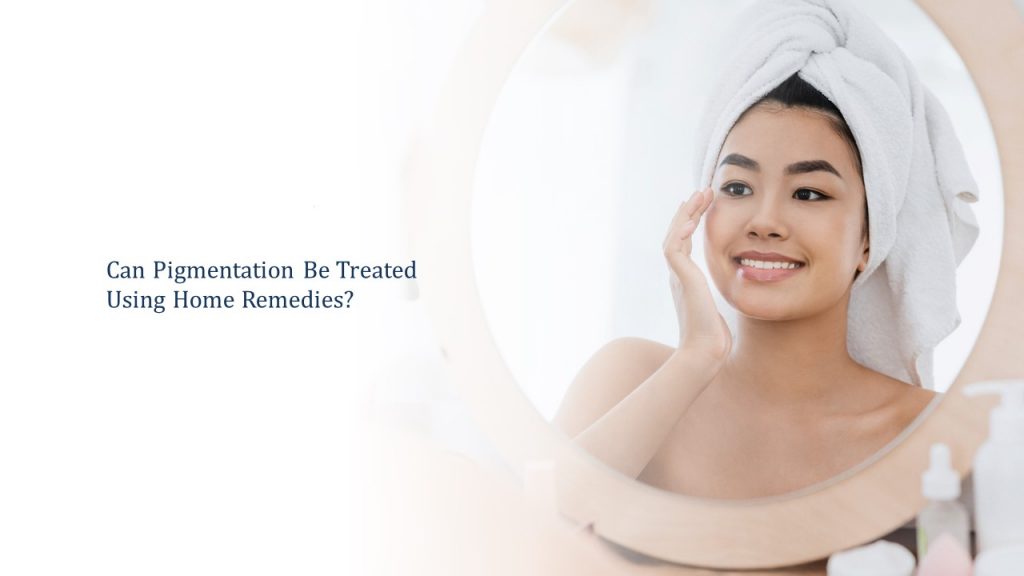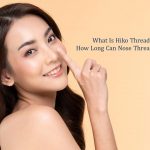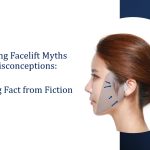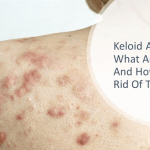Many people living in tropical countries around the world, including Singaporeans, are more likely to get dark spots and pigmentations on their skin.
While many people go for laser for pigmentation removal, others opt for home remedies that are considered to have minimal side effects. But, are home remedies an effective solution to treat skin pigmentation and what other options do you have? Let’s answer this question in this article.
What Is Pigmentation? Why Does It Occur?
Pigmentation refers to a phenomenon in which the pigment melanin is deposited on your skin as dark spots. The melanocytes present in the deeper layers of your skin produce brown pigments, called melanin, when they are irritated by inflammation-instigators, such as sun exposure, estrogen, free radicals, or heat. The melanin is then deposited on the outer layer of your skin and serves to absorb light while also working as an antioxidant agent.
Types Of Pigmentation
The most common pigmentation types include:
- Melasma
- Freckles
- Solar Lentigo
- Hori’s naevus
- Post-inflammatory Hyperpigmentation (PIH)
- Seborrheic keratosis (“age-spots”)
Pinpointing The Cause Of Your Pigmentation
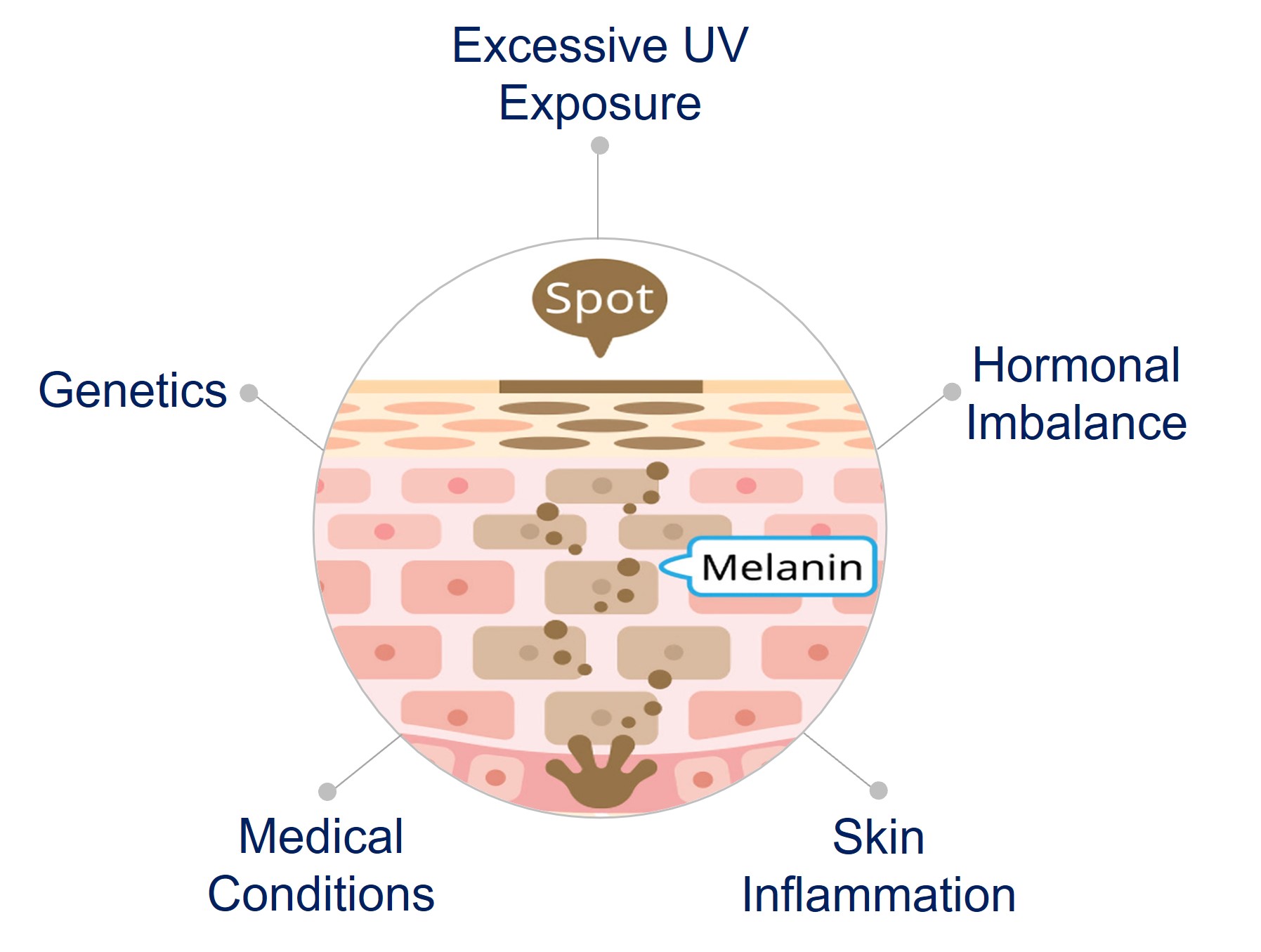
Hyperpigmentation is a condition in which dark patches appear on your skin. There are several causes that lead to the development of hyperpigmentation. In case you have hyperpigmentation, and you’re wondering what could probably be the cause, read on to find out more.
1. Excessive Sun Exposure
One of the most common causes of hyperpigmentation is sun exposure. Suns UV Rays trigger the production of melanin within the deeper layers of your skin in order to protect it from the injurious impact of UV. This is the same as sun tanning, but the production of melanin leads to the formation of dark spots.
2. Hormonal Imbalance
Hormonal fluctuations in your body, either natural or caused by certain medicines such as NSAIDs, antimalarial drugs, and antipsychotic medications, can also stimulate hyperpigmentation. These appear as brownish discoloration or patchy spots on your skin called melasma. This is frequently found in women, particularly during pregnancy or in those undergoing hormonal therapy.
3. Skin Inflammation
A skin injury can also be a cause of hyperpigmentation, be it due to a surgical scar, acne, or inflammation – all of these can be a cause of deposition of melanin on the superficial layers of your skin as part of a natural recovery response.
4. Medical Conditions
In some cases, pigmentation can also occur due to specific health conditions. For instance, people who have autoimmune diseases, gastrointestinal issues and certain metabolic concerns are at a higher risk of hyperpigmentation.
5. Genetics
Even without excessive sun exposure, some people develop pigmentation. This can occur if they have a genetic predisposition to it, meaning that pigmentation runs in family, and several other family members also have the condition.
Do Home Remedies Really Work?

Home remedies for skin pigmentation do work, helping reduce the severity of the pigmentation and decelerate its progress. However, these remedies can only work for some types of pigmentations, not all.
There are a number of natural remedies available, including turmeric, aloe vera gel, green tea, tomato paste, and more. It is claimed that certain natural remedies lighten your skin.
However, it is unclear what amount of time they would take to show noticeable effects. Hence, a lot of patience is what’s needed when trying out natural remedies. Besides, the effects of natural remedies are not permanent, and you would have to use them regularly for persistent results. Otherwise, their effects will fade away with time.
In addition, some remedies such as ammonia, bleach, and hydrogen peroxide can also lead to irritation of the skin and redness.
Pigmentation Treatment – Home Remedies Or Laser Treatments?
Laser therapy tend to produce visible results much faster than home remedies. Hence, it is favored over home remedies as the go-to treatment option for skin pigmentation. It makes use of a pulse of light for removing the outermost skin layer. This causes the reduction of melanin pigment for the treatment area. However, not all types of pigmentation require laser treatments.
Laser Is Not The Only Option

Having said so, the foremost step to effective therapy is the correct diagnosis. People often opt for laser treatment right away without identifying the type of pigmentation concern. However, this is a clear mistake since all pigmentations are not the same, and lasers are not the most effective option for all of them.
Thus, avoid wasting your money while also exposing yourself to unnecessary side effects. Remember that different pigmentation types need diverse treatment methods for the cure. Many people might not be able to differentiate between the two different pigmentations. Hence, consulting an experienced plastic surgeon or medical doctor is essential to an accurate diagnosis.
Treatment Approaches For Pigmentation

Topical treatments
Topical applications such as hydroquinone-based creams can be used to remove skin pigmentation.
Hydroquinone serves as a key ingredient in the treatment of pigmentation, working to block the production of melanin in the skin. While it is also called ‘bleaching cream,’ it would not cause skin bleaching and doesn’t eliminate pigmentation. Rather, hydroquinone lightens your skin, masking the pigments to some extent.
In some cases, using hydroquinone topical application is necessary on a regular basis for a course of two to four weeks prior to going for laser treatment. This would reduce the chance of spot recurrence. Using hydroquinone as a single treatment option might not eliminate your skin pigmentation as effectively as when using it with other treatment/s in combination. However, hydroquinone should not be applied for more than 3 to 6 months, as further use can lead to its side effect.
Laser treatment
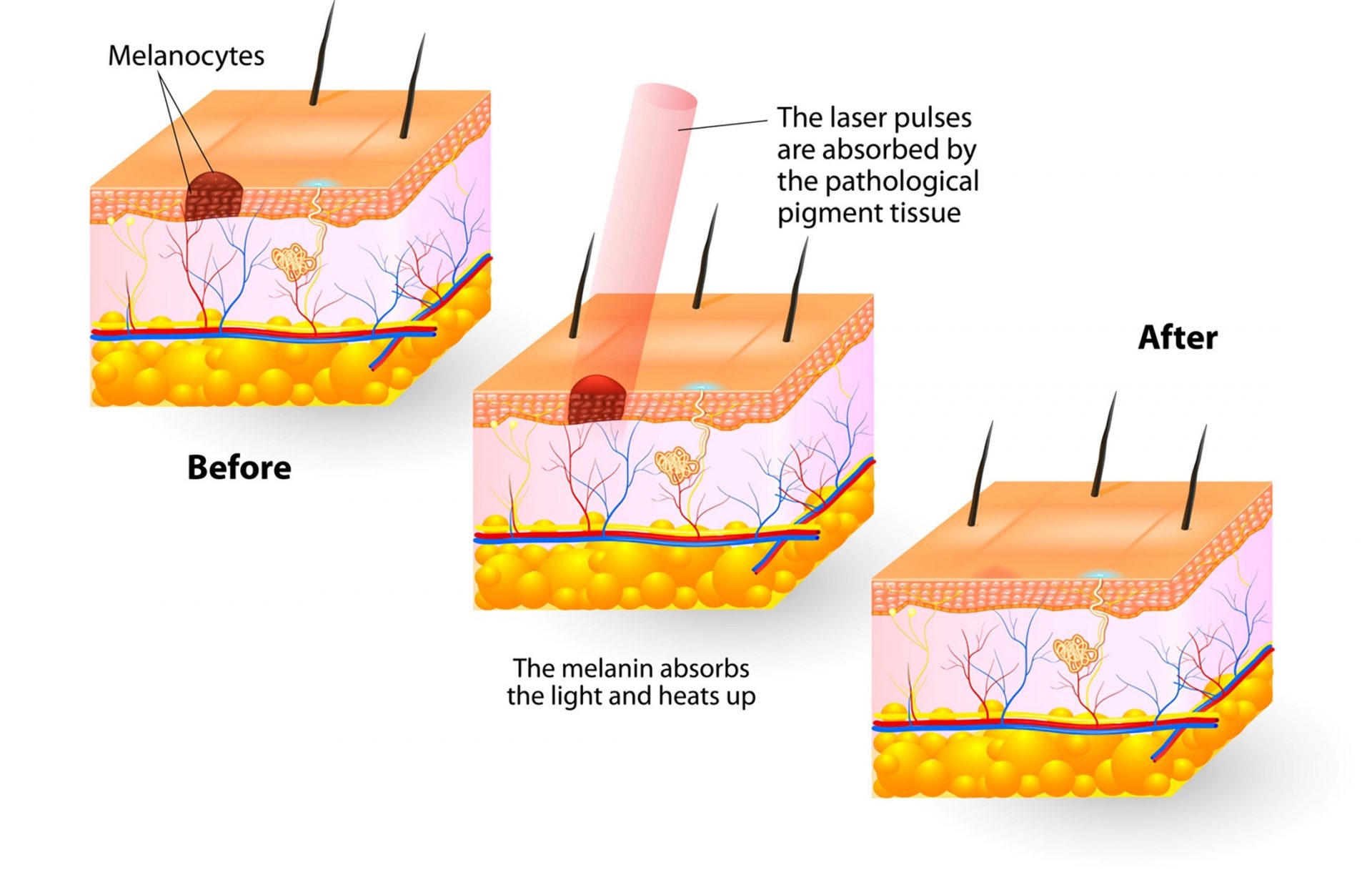
Different types of laser therapies are recommended for different skin pigmentation types. Each type of laser has a different wavelength of laser energy suited to combat certain pigmentation found at specific skin layers.
There are three common types of laser therapies available for different skin pigmentation types. These
include the following.
1.Q-switched laser
The Q-switched laser works at 1064nm wavelength. This type of laser treatment has been a backbone in aesthetic treatments for a long time. While it is used less commonly because of other rapid technologies, such as Pico laser, it can produce heat energy to repair your skin and lighten pigmentation.
The Q-switched laser effectively reduces brown spots and acne marks. Not only is it efficiently lightening the pigments, but it also works to shrink acne and pores on the skin. Repeated Q-switched laser sessions are also needed to maintain the treatment results and prevent dark spots from reappearing.
2.ProYellow Laser
This type of laser treatment utilizes laser energy at 577nm wavelength and ia believed to be safer for used on Asian skin tone.
The ProYellow laser is utilized for several pigmentation conditions, including:
- Vascular lesions
- Sunspots
- Age spots
- Superficial freckles
- Facial flushing
- Acne treatment
- Post acne redness
- Skin rejuvenation and brightening
Its wavelength allows the ProYellow laser to be absorbed by the pigmentation on the skin as well as the blood vessels present underneath. As a result, pigments break down, and a decline in the blood supply occurs to the skin cells, which release the pigments. This is an effective treatment for the removal of pigmentation and produces longer-lasting results.
3.Pico laser:
Pico laser treatment comes in three wavelengths; 532nm, 694nm, and 1064 nm. It can be used for both pigmentation and tattoo removal. Each wavelength targets diverse pigmentations at several skin layers, hence, eliminating pigments more efficiently and rapidly.
Pico laser’s short pulse duration makes it a unique technological advancement. It also has a picosecond pulse duration as compared to the nanosecond pulse duration of the q-switched laser.
1000 pico-seconds equal one nanosecond, which means that the pico laser beam’s firing occurs at a much faster rate than the q-switched laser. The fast laser allows the generation of the photo-acoustic laser energy to fragment pigmentation into smaller particles so the body can eliminate them in a easier.
I Want To Treatment My Pigmentation. Where Do I Start?
Want to know the next steps? Here’s what you should do:
- Choose a reliable cosmetic care center that is reputable.
- Visit your doctor in the first consultation session to ensure you really need laser treatment.
- Be practical about the treatment and keep your expectations as per your case.
- Seek professional advice from the board-certified doctor who is experienced and familiar with the various laser technologies for pigmentation treatment. The newest laser is not always the most effective. Pairing the right laser and the correct power settings for your condition is paramount to seeing visible skin improvements.
Start your journey towards achieving clearer skin at Dream Aesthetics & Plastic Surgery Singapore with a personalized skin assessment.
About Dream Aesthetics and Plastic Surgery
Bespoke surgical for cosmetic or medical reasons is what Dream covers to bring out the beauty in every individual. Going beyond the aesthetics and working on physical anomalies are what we value the most in leading our patients to cherish self-improvement and confident lifestyles.
Derived from Associate Professor Vincent Yeow’s long-standing experience performing plastic surgery in Singapore, our treatment plans deliver physical remodelling in our patients’ favour. One of the notable remodellings is droopy eyelid correction. The ptosis surgery used for treatment eventually fixes drooping eyelids, improves vision and enhances appearance.
Most importantly, as a trustworthy plastic surgery and aesthetic clinic, we treasure positive and natural outcomes for each individual. We will ensure to deliver the beauty refinement of your dream without compromising your safety and privacy.

